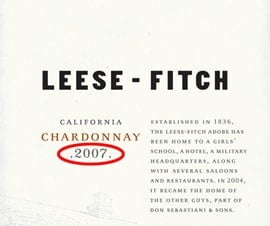
I’m not breaking new ground when I say that wine labels are so bloody difficult to make sense of! The good news is that Californian wine labels are, for the most part, much easier to wrap your head around than European labels. However, they’re still kind-of a minefield!
The following list will help to shed some light on what all that lingo means and hopefully guide you in your wine buying decisions…at least with Californian wines!
Alcohol Content
This is obviously the percentage of alcohol by volume of the wine. California wineries are allowed to label with a 1.5% variation in alcohol, either high or lower. This is variation is allowed since it’s impossible to accurately predict the final alcohol content of a wine in advance of its bottling. It’s also worth noting that wines above 14% ABV pay higher taxes than wines with less than 14% ABV. For this reason, wineries will “take extra steps” to keep their wines at (or at least labeled at) 14% ABV or lower.
AVA (American Viticultural Area)
Examples of AVAs include Napa, Sonoma, Carneros, Alexander Valley etc. If a bottle names  an “AVA” on its label, 85% of the grapes must have come from that area. With the label on the right, the AVA is Clarksburg.
an “AVA” on its label, 85% of the grapes must have come from that area. With the label on the right, the AVA is Clarksburg.
“Bottled By”
Indicates that the winery did indeed bottle the wine, but other 3rd parties grew the grapes, crushed, fermented, finished, and aged the wine. This designation is usually only seen on some of the larger wine brands.
A Simple “California” Designation
This one is kind of tricky, but stay with me because it’s EXTREMELY important!
If a bottle simply states that it hails from “California,” 100% of the grapes must come from  California; however, only a minimum of 75% of the wine has to be made from the named grape.
California; however, only a minimum of 75% of the wine has to be made from the named grape.
This Mark West label is a great example.
Pinot Noir is a notoriously tough (and therefore expensive) grape to grow. For that reason, you can be assured that not many producers will be making their simple “California” labeled wines with much more than the 75% grape minimum mandated by State wine law. They usually blend in other grapes such as Petite Sirah in order to make up the remaining 25% to give the wine color and body.
There’s nothing wrong with these types of wines, and they’re usually a great value; but at least you know know what you’re getting for your $s the wine comes from a more specific place!
 Contains Sulfites
Contains Sulfites
As of 1988, “contains sulfites” is a mandatory statement on all wines with 10 parts per million or higher.
I’m not explaining about sulfites again in this article, so you’ll just have to read back on some of my previous posts on the subject.
The two things I will say is that:
– sulfites are not the reason for your wine headache!
– I’ve tasted “sulfite free” wine before, and they usually taste like sh*t. The other downside is that they start to die very quickly after the cork has been popped.
“Estate Bottled”
“Estate Bottled” means that 100% of the wine has come from grapes grown on land owned by the winery, located in the named wine growing region. The winery then crushes and ferments the grapes, finishes, ages, processes and bottles the wine, basically meaning that they have full control from start to finish. Sometimes this will also be seen as “grown, produced and bottled by.”
 “Old Vine” “Ancient Vines” etc…
“Old Vine” “Ancient Vines” etc…
Sorry to tell you this, but there is no legal definition how old a vine has to be to be use the term “Old Vine.” It means nothing! All it is, is a very cool marketing tactic. Therefore, a statement such as: “I love/will only drink ‘old vine’ Zinfandel!” means absolutely nothing.
Now, there are Zinfandel producers that pride themselves on producing wine that is actually from vines which could be classified as “old,” but in my humble opinion California needs to get its act together and agree on a legal definition for the term to avoid confusion for consumers!
 “Meritage”
“Meritage”
Meritage has to be one of the most misunderstood and mispronounced wine words with regard to Californian wine. With that being said, let’s get the pronunciation out of the way: “Mare-eh-tidge” is correct, and “Mare-eh-targe” is not.
Do me a favor, and pass-on this small piece of information to as many people as you can! I hear Meritage pronounced incorrectly more often than not!
In order to be considered for “Meritage” designation, the wine must meet a strict criteria, namely:
· It must be the winery’s best wine for its style.
· Production must be limited to 25,000 cases for each year.
· The wine must be a blend of at least two, with no one of the grapes making up more than 90% of the blend. For reds, these grapes are: Cabernet, Cabernet Franc, Merlot, Malbec, Petite Verdot and Carmenère. For whites, the grapes are: Sauvignon Blanc, Semillon and Muscadelle.
 “Produced And Bottled By”
“Produced And Bottled By”
This indicates that the winery crushed, fermented and bottled a minimum of 75% of the wine in the bottle, with the other 25% allowed to be bought from other sources. It does not mean that the winery grew the grapes used in the wine.
“Reserve”
This one always throws-off a lot of people!
There is no legal definition on the term “Reserve,” (at least in California). “Reserve” can be used on a $200 bottle or on a $2 bottle. Some wineries use the term to denote a higher end wine that they produce, as with the label on the left.
Specific Vineyard Designations
If a bottle names a specific vineyard on the label (see Corison label), 95% of the grapes legally have to have come from that named vineyard. This doesn’t mean to say that the  winery owns that specific vineyard, and more often than not it’s owned independently.
winery owns that specific vineyard, and more often than not it’s owned independently.
The general school of thought is that the grapes grown on a very specific piece of land are typically higher in quality and more indicative of its terroir. Usually, you can expect to pay a premium for vineyard-specific wines.
Varietal Designations
Naming the grape on a label means that an absolute minimum of 75% of that particular grape variety is used in the wine. Wines which do not contain 75% of a single grape variety often have proprietary names or may be designated such as “Red Table Wine.”

Vintage Designations
If a wine is vintage labeled, then 85% of the grapes used must be from that year. However if an AVA (Napa, Sonoma, Carneros etc) is also indicated, then 95% of the grapes must be from that year. If no vintage is found on a label, chances are that the wine is a blend from a couple of different years.

